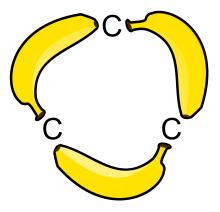Bent bond

In organic chemistry, a bent bond, also known as a banana bond, is a type of covalent chemical bond with a geometry somewhat reminiscent of a banana. The term itself is a general representation of electron density or configuration resembling a similar "bent" structure within small ring molecules, such as cyclopropane (C3H6) or as a representation of double or triple bonds within a compound that is an alternative to the sigma and pi bond model.
Small cyclic molecules

Bent bonds
In these compounds, it is not possible for the carbon atoms to assume the 109.5°
Walsh orbital model
An alternative model utilizes semi-localized Walsh orbitals in which cyclopropane is described as a carbon sp2 sigma bonding and in-plane pi bonding system. Critics of the Walsh orbital theory argue that this model does not represent the ground state of cyclopropane as it cannot be transformed into the localized or fully delocalized descriptions via a unitary transformation.[3]
Double and triple bonds
Two different explanations for the nature of double and triple covalent bonds in organic molecules were proposed in the 1930s. Linus Pauling proposed that the double bond results from two equivalent tetrahedral orbitals from each atom,[7] which later came to be called banana bonds or tau bonds.[8] Erich Hückel proposed a representation of the double bond as a combination of a sigma bond plus a pi bond.[9][10][11] The Hückel representation is the better-known one, and it is the one found in most textbooks since the late-20th century.
Both models represent the same total electron density, with the orbitals related by a unitary transformation. We can construct the two equivalent bent bond orbitals h and h' by taking linear combinations h = c1σ + c2π and h' = c1σ – c2π for an appropriate choice of coefficients c1 and c2. In a 1996 review, Kenneth B. Wiberg concluded that "although a conclusive statement cannot be made on the basis of the currently available information, it seems likely that we can continue to consider the σ/π and bent-bond descriptions of ethylene to be equivalent."[3] Ian Fleming goes further in a 2010 textbook, noting that "the overall distribution of electrons [...] is exactly the same" in the two models.[12]
Other applications
The bent bond theory can also explain other phenomena in organic molecules. In fluoromethane (CH3F), for instance, the experimental F–C–H bond angle is 109°, which is greater than the calculated value. This is because according to Bent's rule, the C–F bond gains p-orbital character leading to high s-character in the C–H bonds, and H–C–H bond angles approaching those of sp2 orbitals – e.g. 120° – leaving less for the F–C–H bond angle. The difference is again explained in terms of bent bonds.[3]
Bent bonds also come into play in the
References
- .
- .
- ^ .
- ISBN 0-306-41198-9.
- .
- .
- ..
- ..
- S2CID 120342054.
- .
- ..
- ISBN 978-0-470-74658-5..



